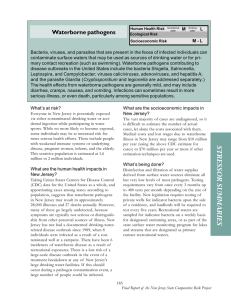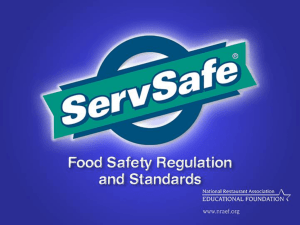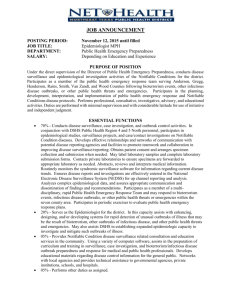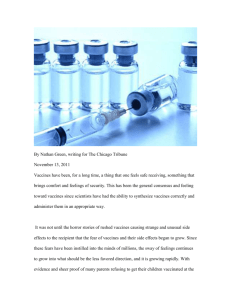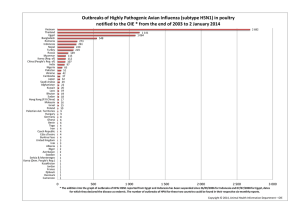CSTE position statement 07-EC-02 recognized the need to develop an... notifiable conditions and a standardized reporting definition for each condition... 09-ID-02
advertisement
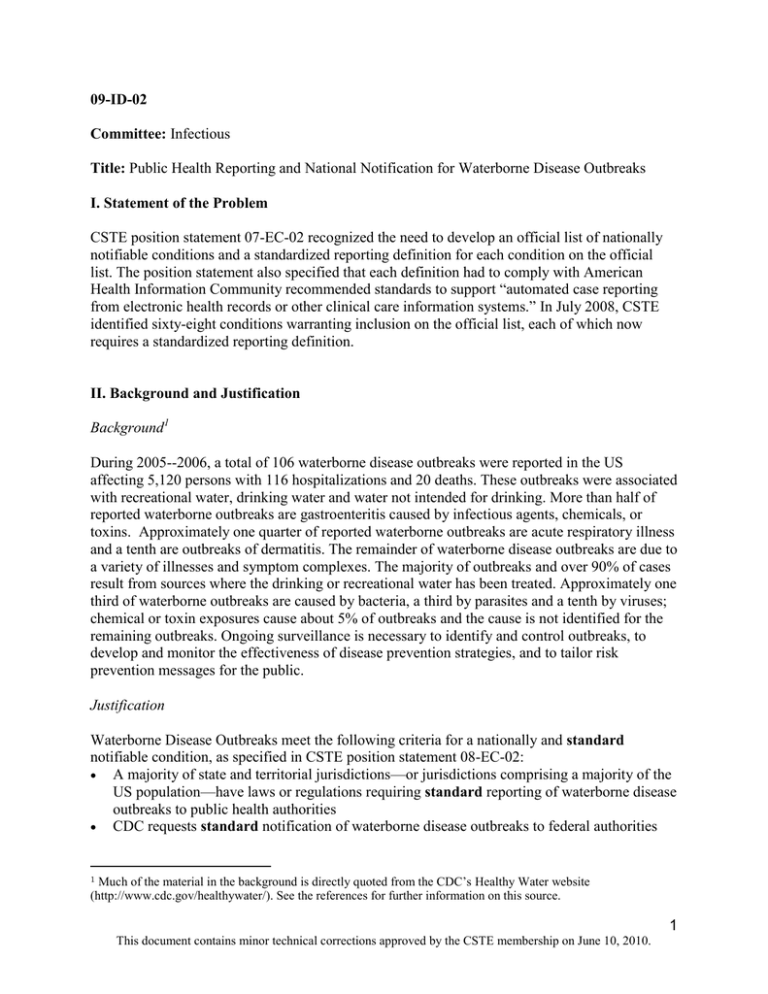
09-ID-02 Committee: Infectious Title: Public Health Reporting and National Notification for Waterborne Disease Outbreaks I. Statement of the Problem CSTE position statement 07-EC-02 recognized the need to develop an official list of nationally notifiable conditions and a standardized reporting definition for each condition on the official list. The position statement also specified that each definition had to comply with American Health Information Community recommended standards to support ―automated case reporting from electronic health records or other clinical care information systems.‖ In July 2008, CSTE identified sixty-eight conditions warranting inclusion on the official list, each of which now requires a standardized reporting definition. II. Background and Justification Background1 During 2005--2006, a total of 106 waterborne disease outbreaks were reported in the US affecting 5,120 persons with 116 hospitalizations and 20 deaths. These outbreaks were associated with recreational water, drinking water and water not intended for drinking. More than half of reported waterborne outbreaks are gastroenteritis caused by infectious agents, chemicals, or toxins. Approximately one quarter of reported waterborne outbreaks are acute respiratory illness and a tenth are outbreaks of dermatitis. The remainder of waterborne disease outbreaks are due to a variety of illnesses and symptom complexes. The majority of outbreaks and over 90% of cases result from sources where the drinking or recreational water has been treated. Approximately one third of waterborne outbreaks are caused by bacteria, a third by parasites and a tenth by viruses; chemical or toxin exposures cause about 5% of outbreaks and the cause is not identified for the remaining outbreaks. Ongoing surveillance is necessary to identify and control outbreaks, to develop and monitor the effectiveness of disease prevention strategies, and to tailor risk prevention messages for the public. Justification Waterborne Disease Outbreaks meet the following criteria for a nationally and standard notifiable condition, as specified in CSTE position statement 08-EC-02: A majority of state and territorial jurisdictions—or jurisdictions comprising a majority of the US population—have laws or regulations requiring standard reporting of waterborne disease outbreaks to public health authorities CDC requests standard notification of waterborne disease outbreaks to federal authorities 1 Much of the material in the background is directly quoted from the CDC’s Healthy Water website (http://www.cdc.gov/healthywater/). See the references for further information on this source. 1 This document contains minor technical corrections approved by the CSTE membership on June 10, 2010. CDC has condition-specific policies and practices concerning the agency’s response to, and use of, notifications. Data are collected on waterborne disease outbreaks to characterize the frequency, source, number of people affected, severity of infection, and agent involved. These data are collected in order to understand the causes of waterborne disease outbreaks in the United States so that recommendations to decrease the frequency may be made. III. Statement of the desired action(s) to be taken CSTE requests that CDC adopt this standardized reporting definition for waterborne disease outbreaks to facilitate timelier, complete, and standardized local and national reporting of this condition. IV. Goals of Surveillance To provide information on the temporal, geographic, and demographic occurrence of waterborne disease outbreaks to facilitate their prevention and control. V. Methods for Surveillance Surveillance for waterborne disease outbreaks should use the sources of data and the extent of coverage listed in Table V. Table V. Recommended sources of data and extent of coverage for ascertaining waterborne disease outbreaks. Coverage Source of data for case ascertainment Population-wide clinician reporting X laboratory reporting X reporting by other entities (e.g., hospitals, veterinarians, pharmacies) X Sentinel sites death certificates hospital discharge or outpatient records extracts from electronic medical records telephone survey school-based survey other _____________________ 2 This document contains minor technical corrections approved by the CSTE membership on June 10, 2010. VI. Criteria for Reporting Reporting refers to the process of healthcare providers or institutions (e.g., clinicians, clinical laboratories, hospitals) submitting basic information to governmental public health agencies about cases of illness that meet certain reporting requirements or criteria. Cases of illness may also be ascertained by the secondary analysis of administrative health data or clinical data. The purpose of this section is to provide those criteria that should be used to determine whether a specific illness should be reported. A. Narrative description of criteria to determine whether a waterborne disease outbreak should be reported to public health authorities Report any outbreak to public health authorities that meets any of the following criteria: An incident in which two or more epidemiologically-linked persons experience a similar illness after exposure to the same water source and epidemiologic evidence implicates the water as the source of the illness. The implicated water may be drinking water, recreational water, water not intended for drinking (e.g., water used for agricultural purposes or in a cooling tower) or water of unknown intent. The route of exposure may be ingestion, inhalation, intranasal, or contact. The agent associated with the waterborne disease outbreak may be a microbe, chemical, or toxin. Water testing to demonstrate contamination or identify the etiologic agent is preferred, but not required for inclusion. Chemicals (including disinfection byproducts) in drinking water or in recreational water that cause health effects either through water exposure or by volatilization leading to poor air quality are included. Other recommended reporting procedures All waterborne disease outbreaks should be reported. Frequency of reporting should follow the state health department’s routine schedule. B. Table of criteria to determine whether a waterborne disease outbreak should be reported to public health authorities Table VI-B. Table of criteria to determine whether a case should be reported to public health authorities. Requirements for reporting are established under State and Territorial laws and/or regulations and may differ from jurisdiction to jurisdiction. These criteria are suggested as a standard approach to identifying cases of this condition for purposes of reporting, but reporting should follow State and Territorial law/regulation if any conflicts occur between these criteria and those laws/regulations. 3 This document contains minor technical corrections approved by the CSTE membership on June 10, 2010. Criterion Reporting Epidemiologic Evidence Any outbreak involving two or more persons of an infectious O disease, chemical poisoning or toxin-mediated illness where water is indicated as the source. Notes: O = At least one of these ―O‖ (Optional) criteria in each category (i.e., clinical evidence and laboratory evidence) in the same column is required to identify a case for reporting. C. Disease Specific Data Elements: Disease-specific data elements to be included in the initial report are listed below. Clinical Factors Common symptoms Date of onset Epidemiological Risk Factors Drinking water source Recreational water exposure Type Swimming pool Lake River, stream, creek Canal Location Date Hot tub or spa exposure Exposure to mists or sprays Type Shower Hot tub Spa Other Location Date Exposure to water not intended for drinking Cooling tower Irrigation water Water of unknown intent 4 This document contains minor technical corrections approved by the CSTE membership on June 10, 2010. VII. Case Definition for Case Classification A. Narrative description of criteria to determine whether a case should be classified as confirmed is provided: Clinical description Symptoms of illness depend upon etiologic agent. Laboratory criteria for diagnosis Depends upon etiologic agent. Definition A waterborne disease outbreak is an incident in which two or more epidemiologically-linked persons experience a similar illness after exposure to the same water source and epidemiologic evidence implicates the water as the likely source of the illness. Comment The implicated water in these waterborne disease outbreaks may be drinking water, recreational water, water not intended for drinking (e.g., water used for agricultural purposes or in a cooling tower) or water of unknown intent. The route of exposure may be ingestion, inhalation, intranasal, or contact. The agent associated with the waterborne disease outbreak may be a microbe, chemical, or toxin. Water testing to demonstrate contamination or identify the etiologic agent is preferred, but not required for inclusion. Chemicals (including disinfection byproducts) in drinking water or in recreational water that cause health effects either through water exposure or by volatilization leading to poor air quality are included. Reports of waterborne disease outbreaks received through the National Outbreak Reporting System (NORS) are captured in the Waterborne Disease and Outbreak Surveillance System (WBDOSS). Although not reported through NORS, the WBDOSS also accepts single cases of chemical exposure, wound infection and other illnesses, (e.g., Naegleria infections) that are epidemiologically linked to water exposure as well as aquatic facility-related health events (e.g., chemical mixing accidents or air quality problems). However, these single cases or aquatic facility-related health events are not reported or analyzed as waterborne disease outbreaks. See also: http://www.cdc.gov/healthywater/statistics/wbdoss/index.html B. Classification Tables Table VII-B lists the criteria that must be met for an outbreak to be classified as confirmed. 5 This document contains minor technical corrections approved by the CSTE membership on June 10, 2010. Table VII-B. Table of criteria to determine whether a case is classified. Outbreak Definition Confirmed Criterion Epidemiologic Evidence Any outbreak of an infectious disease, chemical O poisoning or toxin-mediated illness where water is indicated as the source by an epidemiological investigation. Notes: O = At least one of these ―O‖ (Optional) criteria in each category (i.e., clinical evidence and laboratory evidence) in the same column—in conjunction with all ―N‖ criteria in the same column—is required to classify a case. VIII. Period of Surveillance Surveillance should be on-going. IX. Data sharing/release and print criteria CDC requests notification of waterborne disease outbreaks. Data for waterborne disease outbreaks are summarized biennially for the MMWR Surveillance Summaries and may be included in MMWR or journal articles on waterborne disease as needed to describe the frequency and distribution of waterborne disease outbreaks. Interim data on waterborne outbreaks are provided to states upon request. Case-specific data are not included. X. References 1. Centers for Disease Control and Prevention (CDC). Case definitions for infectious conditions under public health surveillance. MMWR 1997; 46(No. RR-10):1–57. Available from: http://www.cdc.gov/mmwr/ 2. Centers for Disease Control and Prevention (CDC). National notifiable diseases surveillance system: case definitions. Atlanta: CDC. Available from: http://www.cdc.gov/ncphi/disss/nndss/casedef/index.htm Last updated: 2008 Jan 9. Accessed: 3. Council of State and Territorial Epidemiologists (CSTE). CSTE official list of nationally notifiable conditions. CSTE position statement 07-EC-02. Atlanta: CSTE; June 2007. Available from: http://www.cste.org. 6 This document contains minor technical corrections approved by the CSTE membership on June 10, 2010. 4. Council of State and Territorial Epidemiologists (CSTE). Criteria for inclusion of conditions on CSTE nationally notifiable condition list and for categorization as immediately or routinely notifiable. CSTE position statement 08-EC-02. Atlanta: CSTE; June 2008. Available from: http://www.cste.org. 5. Council of State and Territorial Epidemiologists (CSTE). Improving Detection, Investigation, and Reporting of Waterborne Disease Outbreaks 06-ID-012. Atlanta: CSTE; June 2005. Available from: http://www.cste.org. 6. Council of State and Territorial Epidemiologists (CSTE). Data Release Guidelines of the Council of State & Territorial Epidemiologists for the National Public Health System. Atlanta: CSTE; June 1996. 7. Council of State and Territorial Epidemiologists, Centers for Disease Control and Prevention. CDC-CSTE Intergovernmental Data Release Guidelines Working Group (DRGWG) Report: CDC-ATSDR Data Release Guidelines and Procedures for Re-release of State-Provided Data. Atlanta: CSTE; 2005. Available from: http://www.cste.org/pdffiles/2005/drgwgreport.pdf or http://www.cdc.gov/od/foia/policies/drgwg.pdf. 8. Heymann DL, editor. Control of communicable diseases manual. 18th edition. Washington: American Public Health Association; 2004. 9. Yoder JS, Hlavsa MC, Craun GF, Hill V, Roberts V, Yu PA, Hicks LA, Alexander NT, Calderon RL, Roy SL, Beach MJ; Centers for Disease Control and Prevention (CDC). Surveillance for waterborne disease and outbreaks associated with recreational water use and other aquatic facility-associated health events--United States, 2005-2006. MMWR Surveill Summ. 2008;57:1-29. 10. Yoder J, Roberts V, Craun GF, Hill V, Hicks LA, Alexander NT, Radke V, Calderon RL, Hlavsa MC, Beach MJ, Roy SL; Centers for Disease Control and Prevention (CDC). Surveillance for waterborne disease and outbreaks associated with drinking water and water not intended for drinking--United States, 2005-2006. MMWR Surveill Summ. 2008;57:39-62. 7 This document contains minor technical corrections approved by the CSTE membership on June 10, 2010. XI. Coordination: Agencies for Response: (1) Thomas R. Frieden, MD, MPH Director Centers for Disease Control and Prevention 1600 Clifton Road, NE Atlanta GA 30333 (404) 639-7000 txf2@cdc.gov XII. Submitting Author: (2) Bela Matyas Chief, Disease Investigations Section California Department of Public Health 850 Marina Bay Parkway Richmond, CA 94804 Bela.matyas@cdph.ca.gov Co-Authors: (1) Harry F. Hull, Medical Epidemiologist HF Hull & Associates, LLC 1140 St. Dennis Court Saint Paul, MN 55116 (651) 695-8114 hullhf@msn.com (2) Cecil Lynch, Medical Informaticist OntoReason 7292 Shady Woods Circle Midvale, UT 84047 (916) 412.5504 clynch@ontoreason.com (3) R. Gibson Parrish, Medical Epidemiologist P.O. Box 197 480 Bayley Hazen Road Peacham, VT 05862 (802) 592-3357 gib.parrish@gmail.com 8 This document contains minor technical corrections approved by the CSTE membership on June 10, 2010.

